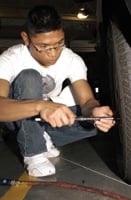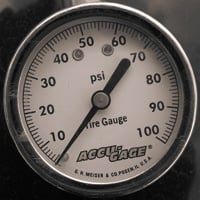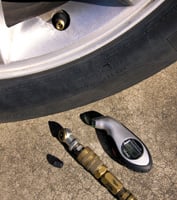RVers have a lot riding on their tires. To that end, keeping an eye on tire pressure is a critical part of regular inspection and maintenance. And what’s the tool for that? The humble tire gauge. How accurate is your tire gauge—and how important is it?
Tire pressure is a critical function in many different ways. Underinflated (or grossly overinflated) tires don’t handle safely, and if you find yourself in a “steer out of trouble” situation, improperly inflated tires can get you into a lot of trouble. Low tires heat up and can blow out, not only destroying the tire but also putting you in an accident-likely situation.
Keeping tires properly inflated also makes sense from a dollars and sense perspective: Underinflated tires wear out more quickly. Overinflated tires can make the ride rough, and actually wear out suspension parts. And yes, fuel economy is really affected by tire inflation. The popular TV investigation program, “Myth Busters,” found running car tires just five psi (pounds per square inch) low sucks 1.2 percent more fuel.
 The solution to these safety and money issues is as simple as regularly checking tire inflation. This translates to the diligent use of a simple tire pressure gauge. But sure enough, our human weaknesses sometimes catch up with us. It seems that as more and more of us get the new technology, including tire pressure warning systems, the temptation is to forgo the tire gauge because, “After all, the warning system will let me know if the pressure is low.” Hang on! The typical tire pressure warning system only alerts when pressure drops below 25 percent of the set rate. On a 65-psi truck tire, that translates to 16 psi low. By some measures, you’ll be spending 5 percent more in fuel for that indiscretion.
The solution to these safety and money issues is as simple as regularly checking tire inflation. This translates to the diligent use of a simple tire pressure gauge. But sure enough, our human weaknesses sometimes catch up with us. It seems that as more and more of us get the new technology, including tire pressure warning systems, the temptation is to forgo the tire gauge because, “After all, the warning system will let me know if the pressure is low.” Hang on! The typical tire pressure warning system only alerts when pressure drops below 25 percent of the set rate. On a 65-psi truck tire, that translates to 16 psi low. By some measures, you’ll be spending 5 percent more in fuel for that indiscretion.
Tire Gauge Choices
With all this in view, it’s obvious an RVer needs an accurate tire pressure gauge. You’ll find tire gauges just about anywhere that car stuff is sold: auto parts stores, big box retailers, and certainly on the Internet. Tire gauges come in three basic types. The “stick” or “pen” type has a plastic or metal indicator that pops up out of the body of the unit. You can pick up a simple stick gauge for as little as a buck. Dial gauges have a “needle on a scale” system; we’ve seen some for sale as low as $5. The latest technology is a digital unit where direct readings are indicated by an electronic display. Prices here start for less than $10 and shoot up to over $100. Still, the bottom line question is, how can you be sure you’ll get an accurate gauge?
One RVer with access to a calibrated air pressure “standard” tested nearly 40 tire gauges of various types. Brand new and used units made up those he tested, and some things became immediately clear: Don’t count on the accuracy of cheap stick-style gauges. Five brand-new stick gauges, fresh off the shelf, were tested, and each one gave a different reading. Larger stick-type gauges, as might be used by folks with dual tires (needing a “double head”), were better in accuracy then the shirt-pocket-sized gauges, even so they rarely met an accurate mark. Exercising these gauges by pulling the indicators in and out, or lubricating them, did little to help accuracy.
 Dial gauges tended to come closer to a standard for accuracy, but even there, be careful with their use. A dropped gauge can easily lose accuracy, leaving you holding the bag. If you drop your dial gauge, it may be best to replace it.
Dial gauges tended to come closer to a standard for accuracy, but even there, be careful with their use. A dropped gauge can easily lose accuracy, leaving you holding the bag. If you drop your dial gauge, it may be best to replace it.
Top Models
What about digital gauges? Consumer Reports magazine recently published the results of tests it made on 14 tire gauges. Of the top three rated gauges, two were digital, one a dial. All three got excellent marks for accuracy and durability, and scored “very good” in terms of ease of use. The top two digital models were made by Accutire, models MS-4400B and MS-4021B. Both of these gauges retail for less than $12 each. The third-ranked Intercomp model 360060 was a dial model, and retailed for over $50. So in the world of tire gauges, “you get what you pay for” may not apply. Mind you, just because a tire gauge is a digital device doesn’t mean accuracy is assured. Three digital units tested were marked as only “good” or “fair,” while one stick model got a “very good” rating for accuracy.
Whichever gauge you buy, treat it carefully. Dropping any gauge can result in accuracy issues. Digital models operate on batteries, and batteries, with time and use, do tend to wear out. A weak battery could result in inaccurate readings, so keep an eye on them.
 Finally, check and inflate your tires with accuracy. Test tires when “cold,” before you pull out. If you can’t fill the tire without moving the rig, then write down how low each tire is. When you get to the filling location, recheck the tire pressure, then add however many pounds you were low to the reading you get at the station. Just traveling a couple of miles can heat up the tire (and the air inside) enough to make a big difference.
Finally, check and inflate your tires with accuracy. Test tires when “cold,” before you pull out. If you can’t fill the tire without moving the rig, then write down how low each tire is. When you get to the filling location, recheck the tire pressure, then add however many pounds you were low to the reading you get at the station. Just traveling a couple of miles can heat up the tire (and the air inside) enough to make a big difference.
Russ and Tiña De Maris are authors of RV Boondocking Basics—A Guide to Living Without Hookups, which covers a full range of dry camping topics, and Camp Hosting USA—Your Guide to State Park Volunteering. Visit icanrv.com for more information.

hi!
Replacing your truck tires is one of the regular expenses to be expected when operating a commercial truck. Irregular wear, however, can force you to replace truck tires early and waste money.
hi!
Many states regulate pets traveling through, just to ensure that they are not bringing any diseases into the state. If you get pulled over, authorities will likely ask for a health certificate, proof of vaccinations, or something similar from your veterinarian.